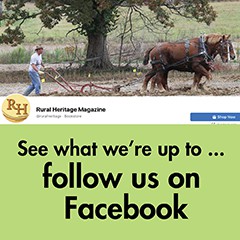This question is something I have been pondering over. Personally, I have never owned drafts although I have owned several other horses including riding horses and buggy horses and have hitched and driven my neighbors team of Percherons numerous times. At the present I own no horses as I and my family are stationed in Togo, West Africa as missionaries in a little rural bush village. My mother sent a package to us in the mail and included a few Rural Heritage magazines as well as a Father's Day gift of Uncle Joe's books "America's Rural Yesterday" volume 1 & 2. Very interesting! Also extremely interesting to show to these African farmers how our ancestors farmed! In our region, animals are not used. All soil turning, hoeing, planting, and harvesting is done strictly by hand. (The farming methods used here could be another subject all on its own.) Anyways, as I have been reading and perusing the magazines and books, I see that almost all draft horses have blinders, but not all. In J. C. Allen's photos, you will find in the same hitch where some horses have blinders and some don't. In the recent Aug./Sept. issue of R.H. on page 33, a four horse hitch is completely blinder-less. Mr. Leo de Visser (page 34) also uses no blinders. Is this personal preference of the teamster? A sign of a well trained horse? An accident waiting to happen? Some questions I've had.

A Bi-Monthly Magazine
Borrowing From Yesterday To Do the Work Of Today
Offering Resources to Promote Self-Sufficient & Back-to-the-Land Living
Uncle Joe says 2015-11-06 09:17:40 (CST)
An excellent question. I look forward to hearing some opinions. Here is a photo provided by Stephen Leslie, courtesy of Paul Schmit of Luxembourg, to accompany a story of his that will appear in the next issue of RH. Bitless and blinderless. Pretty sure this horse may be used mostly as a single between shafts in the field.

8 years ago via Forums | Front Porch Forum
Klaus Karbaumer says 2015-11-06 18:44:09 (CST)
Some time ago I referred Front Porch visitors to videos from the October fest parades in Munich, Bavaria. Pretty much all of the draft horses there pulling the beer drays and floats are working in the midst of the ongoing pandemonium without blinders. I myself had rarely used blinders on my horses back in Bavaria. That all changed when I came here as I always bought horses that had been trained with blinders right from the beginning. When I bought Sam, one of my Percherons at the age of five he seemed calm enough that I would try working him without blinders, and that's what he is doing now. Nash, on the other hand, who was 12 when I bought him last year, even though he is a terrific horse gets terrified ( pun intended) when he sees something behind him.
It's all a question of how early and how intensely horses get trained. I find they are more reliable and safer if they have learned to work without blinders, because almost nothing scares them. I used to do some logging in Bavaria for firewood or to clear out dense woodlots for some of my farmer neighbors and we often had to pull down standing trees that got entangled with others on the top. My horses did that without blinders and without any big excitement when those trees then came crashing down.
I guess the preference for blinders is based in the fact that it is more work and time intensive to train without and that one has to start earlier. In Bavaria, where few farmers had more than two mares, it was customary to treat the foals with a lot of care right from the beginning, they didn't grow up on pastures with only little human contact like many horses here in the States and so they were a little tamer when they got started. The same holds true for Belgium, where you also see the majority of horses worked without blinders.
8 years ago via Forums | Front Porch Forum
burlcreekfarm@juno.com says 2015-11-06 19:56:06 (CST)
Blinders were installed on driving bridles and racing bridles originally to keep them from shying or spooking when another horse or vehicle came up on them from behind. Some horses are bothered by this less than others. Much of the use of them is more decorative today than functional. I have seen many times in the woods where they have protected my horses eyes from tree branches, though. I'll stick to using them. Mark.
8 years ago via Forums | Front Porch Forum
Dick Hutchinson says 2015-11-07 09:48:31 (CST)
I have four books, mostly photos, of horses being used in the late 1800/early1900s. Of all the photos of war and fire horses only one team was in blinders. These war/fire horses probably had things coming at them from all directions.
Like Klaus says they have to be trained to work without blinders.
8 years ago via Forums | Front Porch Forum
Wes Lupher says 2015-11-14 07:56:30 (CST)
I use both.
Most all my colts get started in open bridles. They can be used with either without much trouble.
Some of the snorty ones actually benefit from the open blinders. Seemed to settle down.
I have worked them on spreaders, mowers, rakes, and skidding timber. Doesn't seem to matter.
The horse will let you know if he works better with one or the other if you listen.
8 years ago via Forums | Front Porch Forum





 1
1

